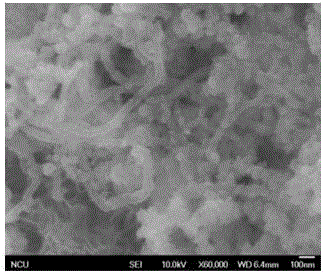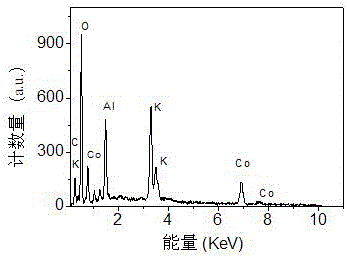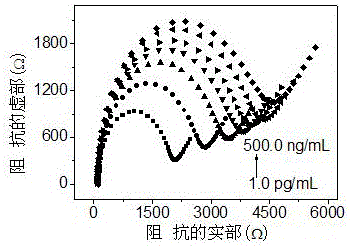A preparation method of nucleic acid aptamer biosensor for detecting thrombin
A nucleic acid aptamer and biosensor technology, applied in the fields of nanomaterials and electroanalytical chemical detection, can solve the problems of low sensitivity and complex sensor operation, and achieve the effect of improving performance
- Summary
- Abstract
- Description
- Claims
- Application Information
AI Technical Summary
Problems solved by technology
Method used
Image
Examples
Embodiment 1
[0026] Nucleic acid aptamer sensors were prepared from hydrotalcite-carbon nanotube composite nanomaterials.
[0027] (1) Mix 10 mL of solution A and 10 mL of suspension B in a beaker to form suspension C.
[0028] Among them, the concentrations of cobalt nitrate and aluminum nitrate in solution A are 0.02mol / L and 0.02 mol / L respectively, and the molar ratio of cobalt nitrate and aluminum nitrate is 1:1; potassium nitrate, potassium chloride and carbon nano The concentrations of the tubes were 0.1 mol / L, 0.05 mol / L, and 0.5 mg / mL, respectively.
[0029] (2) The clean glassy carbon electrode was electrodeposited in the mixed suspension C at the potential of -0.7 V for 80 s to obtain a glassy carbon electrode modified by hydrotalcite-carbon nanotube composite nanoparticles.
[0030] (3) The hydrotalcite-carbon nanotube modified electrode was sequentially placed in 0.5 μmol / L thrombin aptamer for 12 h and soaked in 0.5 mg / mL bovine serum albumin for 40 min to prepare the nuclei...
Embodiment 2
[0032] Nucleic acid aptamer sensors were prepared from hydrotalcite-carbon nanotube composite nanomaterials.
[0033] (1) Mix 15 mL of solution A and 15 mL of suspension B in a beaker to form suspension C.
[0034] Wherein, the concentrations of cobalt nitrate and aluminum nitrate in solution A are 0.03mol / L and 0.02 mol / L respectively, and the molar ratio of cobalt nitrate and aluminum nitrate is 1.5:1; Potassium nitrate, potassium chloride and carbon nano The concentrations of the tubes were 0.2 mol / L, 0.1 mol / L, and 1.5 mg / mL, respectively.
[0035] (2) The clean glassy carbon electrode was electrodeposited in the mixed suspension C at the potential of -0.8 V for 70 s to obtain a glassy carbon electrode modified by hydrotalcite-carbon nanotube composite nanoparticles.
[0036] (3) The hydrotalcite-carbon nanotube modified electrode was sequentially placed in 1.0 μmol / L thrombin aptamer for 12 h and soaked in 1.0 mg / mL bovine serum albumin for 20 min to prepare the nucleic ...
Embodiment 3
[0038] Nucleic acid aptamer sensors were prepared from hydrotalcite-carbon nanotube composite nanomaterials.
[0039] (1) Mix 10 mL of solution A and 10 mL of suspension B in a beaker to form suspension C.
[0040] Wherein, the concentrations of cobalt nitrate and aluminum nitrate in solution A are 0.03mol / L and 0.01 mol / L respectively, and the molar ratio of cobalt nitrate and aluminum nitrate is 3:1; Potassium nitrate, potassium chloride and carbon nano The concentrations of the tubes were 0.3 mol / L, 0.1 mol / L, and 1.0 mg / mL, respectively.
[0041] (2) The clean glassy carbon electrode was electrodeposited in the mixed suspension C at the potential of -0.9 V for 60 s to obtain a glassy carbon electrode modified by hydrotalcite-carbon nanotube composite nanoparticles.
[0042] (3) The hydrotalcite-carbon nanotube modified electrode was sequentially placed in 1.0 μmol / L thrombin aptamer for 12 h and soaked in 1.0 mg / mL bovine serum albumin for 40 min to prepare the nucleic ac...
PUM
 Login to View More
Login to View More Abstract
Description
Claims
Application Information
 Login to View More
Login to View More - R&D
- Intellectual Property
- Life Sciences
- Materials
- Tech Scout
- Unparalleled Data Quality
- Higher Quality Content
- 60% Fewer Hallucinations
Browse by: Latest US Patents, China's latest patents, Technical Efficacy Thesaurus, Application Domain, Technology Topic, Popular Technical Reports.
© 2025 PatSnap. All rights reserved.Legal|Privacy policy|Modern Slavery Act Transparency Statement|Sitemap|About US| Contact US: help@patsnap.com



